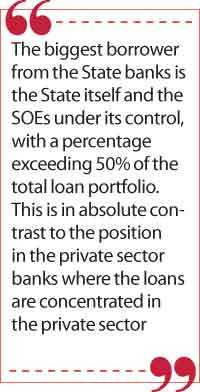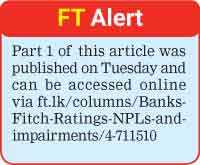Thursday May 15, 2025
Thursday May 15, 2025
Friday, 15 January 2021 00:00 - - {{hitsCtrl.values.hits}}
 According to the above State Bank practices, there are two possibilities of misrepresentation. The first is one bank applies different criteria for the application of regulatory standards for the continuation of public sector loans classified in the performing category and the other treats the same type of lending categorised as sub-standard or doubtful. Then the combined effect gives a completely wry version.
According to the above State Bank practices, there are two possibilities of misrepresentation. The first is one bank applies different criteria for the application of regulatory standards for the continuation of public sector loans classified in the performing category and the other treats the same type of lending categorised as sub-standard or doubtful. Then the combined effect gives a completely wry version.
The second is in relation to the broad comparison between the private sector and the State sector banks. Rating agencies have made specific references to the high percentage of lending to Government in the loan portfolio of State banks.
The biggest borrower from the State banks is the State itself and the SOEs under its control, with a percentage exceeding 50% of the total loan portfolio. This is in absolute contrast to the position in the private sector banks where the loans are concentrated in the private sector.
In a situation where the Fitch ratings has down- graded our sovereign credit rating, attributing inter-alia doubts about the nation’s ability to meet its external debt service obligations, to ‘CCC’ level signifying a ‘a real possibility of default’, the application of impairment standards in respect of borrowings by the State should be more stringent in a realistic analysis.
The application of macroeconomic conditions become more appropriate therefore to the loans of the State banks than the private sector banks where the lending has been on a more secured basis.
The quality of the assets also represents other important features that have to be taken into consideration. Eg: The current outstanding amount due from Sri Lankan Airlines in one State bank is inclusive of the accumulated unpaid interest capitalised. Besides the compounded risk due to this exercise, the bank has already absorbed unearned loan interests and shown as part of their profits already declared!
 |
 |
It is evident that the rating agencies base their projections in a more conservative manner and there is a big variance between the statistical data presented by the Government and these agencies in several areas. They dispute the budget forecasts as highly speculative and ambitious and are critical about the targeted increase in spending and public investment.
Government on the other hand estimates its GDP to grow and the projected investment to be of a higher percentage than estimated by the Fitch ratings. We remain baffled about these divergences and the associated challenges. However history has proven in many instances where the projections have gone astray as well as ignoring the predictions have caused economic calamities.
The references made regarding the failure of the Rating Agencies and others to Forecast the American financial Crisis as highlighted in the Final report of the National Commission on the causes of the Financial and the Economic crisis in the US is the best example for the former and the failure of our own Financial wizards to take adequate notice of and follow the trends during the period preceding the Greece debacle before the impugned sovereign investments we made which caused heavy financial losses to the country is an example for the latter.
It has to be emphasised that the published accounts do not always reflect the true position at a glance. A much more careful and incisive approach is needed to understand the underlying controversial factors. As an example, the quarterly financials in the published Statement of accounts of a State bank as at 30 September 2020, can be cited.
Total loans and advances to customers and others: 1,602,074,504 (in billions of Rs.)
Total loans and advances to the State and SOEs: 840,000,000 (inclusive of Treasury borrowings)
Pawning advances to customers (100% guilt edged): 160, 000,000
Total loans granted to private sector in this bank: 600,000,000
The statement shows a gross NPL ratio of 3.38
NPL ratio of 3.38, out of a loan portfolio of Rs. 1,600 billion, indicate an NPL amount of Rs. 54 billion; (3.38x1600/100)
Because Rs. 54 billion in NPL out of a total loan portfolio of Rs. 1,600 billion gives a ratio of 3.38; (54/1600x100 = 3.38)
Amount transferred to NPL o/a of SOEs in this bank is approximately 2.3 billion
Hence NPL balance applicable to private sector would be 54-2.3 = 51.7 billion
This NPL as a ratio of total lending to private sector is 51.7/600x100 = 8.61
Accordingly, the actual NPL ratio of this bank on account of its private sector lending has to be 8.61 and not 3.38.
Therefore, it will show an entirely different picture compared to the private sector bank NPL averages shown by the Fitch ratings!
However, there have been instances previously where advances by one State bank reportedly amounting to Rs. 30 billion have been absorbed by the Treasury by issuing interest bearing Treasury bonds to that value which the bank in turn swapped with the EPF, thereby clearing their balance sheet to that extent.
This exercise may be resorted to in future too in the most probable situation of some of the advances to SOEs becoming unrecoverable!
There are many aspects that do not fall within the investigative scope of rating agencies before their presumed projections, which they believe are realistic. Nevertheless, the consequences of the rating declarations are very serious and the stressful challenges we are facing to come out of a grave situation will be aggravated.
We have to strive to achieve realistic standards reflecting high asset management qualities and the performance of the State banks to be above board. The Fitch ratings already announced should be regarded as risk signals warranting immediate course corrections.
The State has a duty to free the banks from political manoeuvres as the industry remains virtually regulated by the Government through the CBSL under a situation where all major banks in the private sector too are operating with substantial capital inputs to their share- holdings by the State, while the 100% owned State banks are performing the industry lead role.

Discover Kapruka, the leading online shopping platform in Sri Lanka, where you can conveniently send Gifts and Flowers to your loved ones for any event including Valentine ’s Day. Explore a wide range of popular Shopping Categories on Kapruka, including Toys, Groceries, Electronics, Birthday Cakes, Fruits, Chocolates, Flower Bouquets, Clothing, Watches, Lingerie, Gift Sets and Jewellery. Also if you’re interested in selling with Kapruka, Partner Central by Kapruka is the best solution to start with. Moreover, through Kapruka Global Shop, you can also enjoy the convenience of purchasing products from renowned platforms like Amazon and eBay and have them delivered to Sri Lanka.
Discover Kapruka, the leading online shopping platform in Sri Lanka, where you can conveniently send Gifts and Flowers to your loved ones for any event including Valentine ’s Day. Explore a wide range of popular Shopping Categories on Kapruka, including Toys, Groceries, Electronics, Birthday Cakes, Fruits, Chocolates, Flower Bouquets, Clothing, Watches, Lingerie, Gift Sets and Jewellery. Also if you’re interested in selling with Kapruka, Partner Central by Kapruka is the best solution to start with. Moreover, through Kapruka Global Shop, you can also enjoy the convenience of purchasing products from renowned platforms like Amazon and eBay and have them delivered to Sri Lanka.